Categories: Practical Electronics, All about LEDs
Number of views: 146268
Comments on the article: 3
Some simple LED power schemes
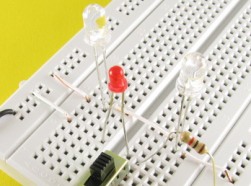 Despite the wide choice in stores of LED flashlights of various designs, hams are developing their own options for powering white super-bright LEDs. Basically, the task boils down to how to power the LED from just one battery or accumulator, to conduct practical research.
Despite the wide choice in stores of LED flashlights of various designs, hams are developing their own options for powering white super-bright LEDs. Basically, the task boils down to how to power the LED from just one battery or accumulator, to conduct practical research.
After a positive result is obtained, the scheme is disassembled, the details are put in a box, the experiment is completed, moral satisfaction ensues. Often, studies stop at this, but sometimes the experience of assembling a particular assembly on a breadboard goes into a real design, made according to all the rules of art. The following are some simple circuits developed by ham radio operators.
In some cases, it is very difficult to establish who is the author of the scheme, since the same scheme appears on different sites and in different articles. Often authors of articles honestly write that this article was found on the Internet, but who published this scheme for the first time is unknown. Many schemes are simply copied from the boards of the same Chinese lanterns.
The author of the article you are reading does not claim to be the author of the circuits either; this is just a small selection of circuits on the “LED” topic.
Why do we need converters
The thing is that a direct voltage drop on LEDas a rule, not less than 2.4 ... 3.4V, so from a single battery with a voltage of 1.5V, and even more so of a battery with a voltage of 1.2V, it is simply impossible to light an LED. There are two ways out. Either use a battery of three or more galvanic cells, or build at least the simplest DC-DC converter.
It is the converter that will allow you to power the flashlight with just one battery. This solution reduces the cost of power supplies, and in addition allows you to more fully use charge of a galvanic cell: many inverters work with deep battery discharge up to 0.7V! Using a converter also reduces the size of the flashlight.
The simplest circuit for powering an LED
The circuit is a blocking generator. This is one of the classic electronics circuits, therefore, with proper assembly and serviceable parts, it starts working immediately. The main thing in this circuit is to correctly wind the transformer Tr1, not to mix the phasing of the windings.
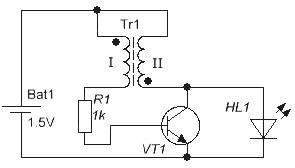
As the core for the transformer, you can use a ferrite ring from the board from the unusable energy saving fluorescent lamp. It is enough to wind several turns of an insulated wire and connect the windings, as shown in the figure below.
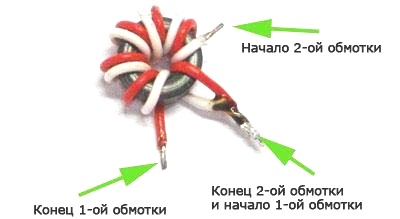
The transformer can be wound with a PEV or PEL type winding wire with a diameter of not more than 0.3 mm, which will allow laying a little more turns, at least 10 ... 15, on the ring, which will slightly improve the operation of the circuit.
Windings should be wound in two wires, then connect the ends of the windings, as shown in the figure. The beginning of the windings in the diagram is indicated by a dot. As transistor you can use any low-power transistor n-p-n conductivity: KT315, KT503 and the like. It is now easier to find an imported transistor, such as the BC547.
If the transistor of the n-p-n structure is not at hand, then you can apply pnp conductivity transistore.g. KT361 or KT502. However, in this case, you will have to change the polarity of the battery.
Resistor R1 is selected according to the best glow of the LED, although the circuit works even if it is replaced simply by a jumper. The above scheme is intended simply for the soul, for conducting experiments. So after eight hours of continuous operation on a single LED, the battery from 1.5V “sits down” to 1.42V. We can say that it is almost not discharged.
To study the load capacities of the circuit, you can try to connect several more LEDs in parallel. For example, with four LEDs, the circuit continues to work quite stably, with six LEDs the transistor starts to heat up, with eight LEDs the brightness decreases noticeably, the transistor heats up very strongly. But the scheme, nevertheless, continues to work. But this is only in the order of scientific research, since the transistor in this mode will not work for a long time.
Converter with rectifier
If you plan to create a simple flashlight on the basis of this scheme, you will have to add a couple more details, which will provide a brighter glow of the LED.

It is easy to see that in this circuit the LED is powered not by pulsating, but by direct current. Naturally, in this case, the brightness of the glow will be slightly higher, and the level of pulsations of the emitted light will be much less. As a diode, any high-frequency, for example, KD521 (principle of operation of a semiconductor diode).
Choke converters
Another simplest diagram is shown in the figure below. It is somewhat more complicated than the diagram in the figure. 1, contains 2 transistors, but instead of a transformer with two windings, it only has an inductor L1. Such a choke can be wound on the ring all from the same energy-saving lamp, for which you need to wind only 15 turns of a winding wire with a diameter of 0.3 ... 0.5 mm.

With the indicated throttle parameter on the LED, it is possible to obtain a voltage of up to 3.8 V (direct voltage drop on the 5730 3.4V LED), which is enough to power a 1W LED. The setup of the circuit consists in selecting the capacitor C1 in the range of ± 50% according to the maximum brightness of the LED. The circuit is operable when the supply voltage is reduced to 0.7V, which ensures maximum use of the battery capacity.
If we supplement the considered circuit with a rectifier on the diode D1, a filter on the capacitor C1, and a zener diode D2, we get a low-power power supply that can be used to power circuits on the op amp or other electronic components. In this case, the inductance of the inductor is selected within 200 ... 350 μH, the diode D1 with a Schottky barrier, the zener diode D2 is selected according to the voltage of the supplied circuit.

With a good combination of circumstances, with the help of such a converter, a voltage of 7 ... 12V can be obtained at the output. If you plan to use the converter to power only the LEDs, the Zener diode D2 can be excluded from the circuit.
All the circuits considered are the simplest voltage sources: current limitation through the LED is carried out approximately in the same way as in various key fobs or in lighters with LEDs.
The LED through the power button, without any limiting resistor, is powered by 3 ... 4 small disk batteries, whose internal resistance limits the current through the LED to a safe level.
Current feedback circuits
And the LED is, nevertheless, a current device. It is not for nothing that the direct current is indicated in the documentation for LEDs. Therefore, these schemes for powering LEDs contain current feedback: as soon as the current through the LED reaches a certain value, the output stage is disconnected from the power source.
Voltage stabilizers also work exactly, only there is voltage feedback. Below is a diagram for powering current feedback LEDs.

A careful examination shows that the basis of the circuit is the same blocking generator assembled on the transistor VT2. Transistor VT1 is the control in the feedback circuit. Feedback in this circuit works as follows.
LEDs are powered by a voltage that builds up on the electrolytic capacitor. The capacitor is charged through the diode by the pulse voltage from the collector of the transistor VT2. Rectified voltage is used to power the LEDs.
The current through the LEDs goes along the following path: plus capacitor, LEDs with limit resistors, current feedback resistor (sensor) Roc, minus electrolytic capacitor.
In this case, a voltage drop Uoc = I * Roc is created on the feedback resistor, where I is the current through the LEDs. With increasing voltage on electrolytic capacitor (the generator, nevertheless, works and charges the capacitor), the current through the LEDs increases, and, consequently, the voltage across the feedback resistor Roc also increases.
When Uoc reaches 0.6V, transistor VT1 opens, closing the base-emitter junction of VT2. Transistor VT2 closes, the blocking generator stops, and stops charging the electrolytic capacitor. Under the influence of the load, the capacitor discharges, the voltage across the capacitor drops.
A decrease in the voltage across the capacitor leads to a decrease in the current through the LEDs, and, as a result, a decrease in the feedback voltage Uoc. Therefore, the transistor VT1 is closed and does not interfere with the operation of the blocking generator. The generator starts and the whole cycle repeats over and over.
By changing the resistance of the feedback resistor, it is possible to widely vary the current through the LEDs. Such circuits are called pulsed current stabilizers.
Integrated Current Regulators
Currently, current stabilizers for LEDs are available in integrated design. As examples, specialized microcircuits ZXLD381, ZXSC300 can be cited. The diagrams shown below are taken from the data sheets of these microcircuits.
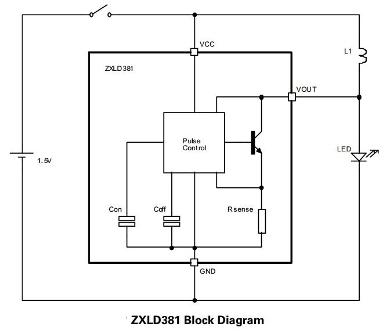
The figure shows the device chip ZXLD381. It contains a PWM generator (Pulse Control), a current sensor (Rsense) and an output transistor. There are only two attachments. This is an LED LED and an L1 inductor. A typical wiring diagram is shown in the following figure. The chip is available in the SOT23 package. The generation frequency of 350KHz is set by internal capacitors, it is impossible to change it. The efficiency of the device is 85%, starting under load is already possible with a supply voltage of 0.8V.

The forward voltage of the LED should be no more than 3.5V, as indicated in the bottom line under the figure. The current through the LED is regulated by changing the inductance of the inductor, as shown in the table on the right side of the figure. In the middle column, peak current is indicated, in the last column, average current through the LED. To reduce the level of ripple and increase the brightness of the glow, it is possible to use a rectifier with a filter.
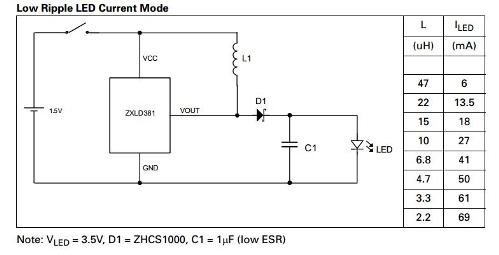
An LED with a direct voltage of 3.5 V is used here, a high-frequency diode D1 with a Schottky barrier, a C1 capacitor, preferably with a low value of equivalent series resistance (low ESR). These requirements are necessary in order to increase the overall efficiency of the device, to heat the diode and capacitor as little as possible. The output current is selected by selecting the inductance of the inductor depending on the power of the LED.
Chip ZXSC300
It differs from ZXLD381 in that it does not have an internal output transistor and a resistor-current sensor. This solution allows you to significantly increase the output current of the device, and therefore apply an LED of greater power.
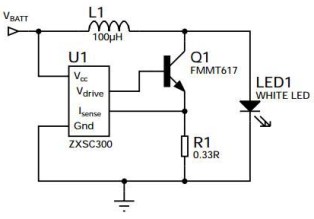
An external resistor R1 is used as a current sensor, by changing the value of which it is possible to set the required current depending on the type of LED. The calculation of this resistor is carried out according to the formulas given in the datasheet on the ZXSC300 chip. We will not give these formulas here; if necessary, it is easy to find a datasheet and spy formulas from there. The output current is limited only by the parameters of the output transistor.
When you turn on all the circuits described for the first time, it is advisable to connect the battery through a 10Ω resistor. This will help to avoid the death of the transistor if, for example, the transformer windings are incorrectly connected. If the LED lights up with this resistor, then the resistor can be removed and further settings made.
Boris Aladyshkin
See also at bgv.electricianexp.com
:
